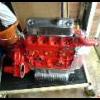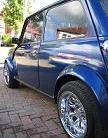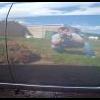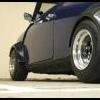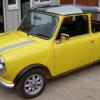FAQ, Ultimate cleaning/polishing guide
#1

Posted 17 August 2005 - 11:37 AM
Poor washing technique and the wrong tools leads to the majority of swirl makes and marring that you see on your cars paint. Swirl marks can be caused by both badly washing by hand and by automatic car washes.
Most good quality car washes are mild on wax, and all of the cars exterior components. The shampoo needs to foam up well and provide good lubrication to stop the dirt scratching the paint, and leave a good gloss finish to the cars appearance. Most car washes are much of the same if you pay for a reasonable one.
Like most things everyone has the personal favourite, as long as it foams up well, produces a slick wash liquid that rinses easily and leaves a good finish I’m happy. I tend to avoid the all in one wash and wax type products. I would rather worry about protecting the paint as separate step.
THE TWO BUCKET METHOD
The favoured method for cleaning a car by hand is known as the two-bucket method. Making sure the paintwork is cool and working in the shade if possible, firstly you need to hose the car down to remove as much of the loose dirt. Hosing alone will not remove all of the dirt, nothing short of a good scrubbing will do. This is where people first introduce marks into the paintwork in the wash process by using a sponge.
The best solution to this is to use a good quality deep pile wash mitt or pad. These hold lots of soapy water and are kind on your paintwork. Unlike normal sponges these are either made of sponge covered with microfiber, cotton or sheepskin, or as a mitt to wear on your hand. The nature of the construction means that the deep pile lets the dirt get drawn down into them away from the paint protecting your finish. Traditional use of normal flat-sided sponges can’t do this, allowing the dirt to be trapped in a sandwich between the sponge and the paint. The dirt and grit then marks and swirls the paint surface, most noticeable if you have a dark paint. Even with a good foamy shampoo, the sponge will still cause damage that will later need to be polished out.
For this process you need two buckets, one with a good quality car wash and water mixture and one with clean rinse water. After washing a part of the car, instead of going straight back into your soapy bucket of wash and back to the car, use the rinse bucket to wash your pad or mitt before putting it into the soapy water and onto the paint. This means your wash bucket stays free from dirt and grit and stays foamy longer. As mentioned earlier choose a wash that is designed for car paintwork. The formulation will allow abrasive dirt to be safely removed with out scratching.
Start from the top and work down, this means that firstly you are starting with the roof, which tends to be the least dirty and allows the soapy water to run down and loosen the dirty bits lower down. During the cooler times of the year it is possible to wash the whole car and then rinse, in summer it may be advisable to do a side of the car at the time or even a panel at a time. You need to rinse often before the shampoo off before it dries, if it does it will streak and leave a film behind.
As well as washing the panels in an order steer clear of washing in circular motions. This way if by chance you do introduce swirl marks during the wash process, the circular motion will make the marks look much worse. For vertical surfaces such as doors, and wings wash in a top to bottom (up and down) motion, and for horizontal panels like the roof and bonnet wash front to back in straight lines, this way any marring caused wont show up so badly in the light.
RINSING
After washing give the car a rinse with a constant flow of water. The best way to do this is with the nozzle of the hosepipe, which allows the water to sheet off the panels rather than bead making drying the car a lot quicker. If the surface is well waxed this method will leave hardly any water to dry up.
DRYING
For drying I prefer to use either or a combination of a synthetic chamois and/or a mirofiber waffle weave drying towel. The latter is probably kinder to you paint. Again start at the top of the car and work you way down. If using a good size towel of chamois place it flat against the paint and pull it along absorbing as much water as you can in one pass. Ring and/or rinse it out often. To prevent steaks fold the towel or chamois into a pad for the final wipe.
WHEEL CLEANING
Taking one wheel and arch at a time rinse of any lose brake dust and dirt with the hose (make sure to get right in the arch with the hose), mix up your car wash to double the normal strength. It maybe a good idea to have a specific bucket just for your wheels so you know there is not any danger of the break dust getting on your paint next time you wash.
If the wheels are really dirty use a wheel cleaner to loosen up the baked on grime. Beware of most wheel cleaners, as they are acid based. I prefer to use Autoglym engine and machine cleaner as it is non acidic so is kinder on your alloys. If you are using an acid based cleaner consider watering it down to reduce the strength. If you have polished and waxed you wheels in the past soapy water should be all you need to clean them, as the protective coating left behind should stop the brake dust etching.
After letting the cleaners do their work for a few minutes, with the soapy water work your way round the tire, the face of the wheel, inside the spokes and rim. If you have very hard to clean wheels with small spokes, use a soft brush to get inside them best you can. After washing rinse the wheels and arches well with a good supply of water and dry.
USE OF THE CLAY BAR
What is a clay bar, and what can it be used for
Clay isn't a polish or a compound, it is a surface preparation bar that smoothes the paint and removes contaminants, Clay is not a replacement for polishing. It's a tool for quickly and easily removing surface contamination
A clay bar is as its name suggests a bar of clay, and is usually used in conjunction with some form of lubricant (or even normal car shampoo), and basically it is used on your cars paintwork/wheels/ and even glass, to remove surface contaminants such as tree sap, tar specks, brake dust etc.
The clay is used after washing the car and before applying waxes etc.
Clay is also very effective on paint over-spray.
Do you need to use a clay bar?
No matter how much you wash and wax your car this is not enough alone to remove certain contaminants, in fact waxing over such contaminants will only seal them onto your paint.
To check if you need to clay simply was your car and dry now simply run your finger- tips across the paint surfaces, which should feel as smooth as glass, if it doesn't then your paint is being attacked by contaminants, Removing these surface contaminants (tar, acid rain spots, bug residue, paint over-spray, brake dust, hard water spots, etc.) will improve both the look and health of your car's paint.
Using clay
Using clay is easy but do follow the manufacturers instructions, if you don't you could create a mess or mark your paint.
Firstly ensure that you car is thoroughly washed and dried, as with all car cleaning try to do it in the shade, and apply to a small area at a time. Then roll your clay into ball, this warms it up and makes it more usable, then mould it into a flat surface, you then spray a small amount of the lubricant onto the panel, and then rub the clay in back and forward motion using light/medium pressure, if it becomes hard to rub then you need to use more lubricant (this is because clay is quite sticky). When you have made a few passes rub your hand over the area and it should be smooth, if it isn't then you just follow the same process again until the area becomes glass smooth, when smooth remove all the residue with a micro fibre towel (a soft cotton towel will suffice also).
When you have completed the whole car it is advisable to wash the car down to remove the lubricant, you car is now ready for glazing/sealing/waxing, etc.
Tip, when you can no longer fold the clay into a clean surface you can use it for claying your glass or even your alloys, it surprising how much dirt you can remove from your cars glass, and likewise clay is perfect for removing brake dust from your alloys (Clay is not recommended on wheels that do not have a factory clear coat or powder coat finish).
Clay safety
1. Clay does have a mild cutting action so be careful in its use.
2. If you drop you clay bar dispose of it, as dirt will engrain itself into the clay, and this will of course scratch your paint.
3. Fold your clay regularly and check the clay often, if you find raised bits remove them with you nails
4. Always Read the manufacturers' instructions.
POLISHING
The term polish and wax are often misunderstood, mixed up and used in place of each other. It does not help when a lot of products on the market blur the lines between a polish and a wax. A polish is a process that should be undertaken infrequently and is simply used to remove minor blemishes, surface scratches and swirl marks. Once you have polished your cars paintwork it will feel smooth.
Polishing a car will remove under the surface defects in comparison to the clay bar above which removes above surface defects. However polishing offers no protection and should be followed with a suitable wax or sealant or indeed both!
Types of Polish
Cutting polishes – These contain tiny abrasive particles and actually remove a very fine layer of paint from the surface of a car. These are also called body scrubs and swirl removers.
Glazes – These are pure polishes and do not actually ‘cut’ the paintwork, instead they nourish and add a deep gloss appearance.
All in ones – These are often what your local Halfords sell and will include a cutting agent, a glaze and a wax all in one. They are quick and easy to use but do not offer the same level of shine or protection as completing the steps individually. In addition regular use of these is not recommended due to the cutting action.
How to apply polish
Do not apply in direct sunlight. Polish can be worked in by hand (foam pad) or by using a random orbital buffer. There is no need to let it dry but do work it in well.
It can then be wiped off with a soft towel to prevent scratching the paintwork. Your paint should now be smooth and ready for waxing!
WAXING AND PAINT SEALANTS
After all your hard work so far you will want to protect your finish from the elements. Waxing or sealing your cars paintwork is a sure fire way of achieving this.
WHICH WAX FOR ME?
There are a vast array of waxes on the market from paint sealants, carnauba waxes and cleaner waxes (all in ones). Waxes also come in paste and liquid form so, which is best for you?
I haven’t stated any wax manufactures below as all manufactures produce a wide range of waxes, however respected manufactures include Mothers, Meguiars, Poorboys, Nattys, Klasse, Zaino and Zymol though this is expensive and similar results can be achieved for a lot less. Wax products bought from Halfords are generally best avoided. Given that Autoglym extra gloss is a good paint sealant.
Pure Wax
More often than not these come in paste form in a tin. They provide your car with a warm gloss look but are not overly durable and require re application every month or so depending upon your cars usage. These waxes can be very good at hiding (covering) swirl marks in paint
Paint Sealants – (Synthetic waxes)
These are in effect synthetic waxes. These last longer than the traditional carnauba wax but purists would say do not offer the same level of warmth to your paint that a carnauba wax would. These often come in a liquid form and are often applied to the car as a whole and left to ‘cure’ before being buffed off. For a great look ‘top’ your paint sealant with a pure carnauba wax for added shine and protection.
Cleaner Wax
This is a mixture of polish and wax and in effect combines the steps of polishing and waxing. Often these contain cutting agents and can hide or assist in the removal of swirl marks. A cleaner wax is useful to save time but will not give you the same results if the steps are done individually. These are best avoided for regular use but can achieve good results on older undamaged paintwork.
Colour Waxes
These contain synthetic waxes and heaps of colour ‘fillers’ which very effectively hide the swirl marks and scratches on a car. However the fillers tend to wash out revealing the scratches again. These are best avoided and any swirl removal should be done in the polishing stage above.
Applying Wax
Work in a cool shaded area out of direct sunlight.
Use a foam pad to apply the wax.
Work on one area at a time. Some products may allow you to coat the entire car before buffing off, but most do not.
Follow the wax manufacturer's instructions on whether or not to allow the wax to dry before buffing.
Use a small amount of wax at a time, and rub it in well.
If the wax residue does not buff off easily, switch to a clean micro fibre or terry towel.
Apply your wax in a back-and-forth motion, not in circles. If you are creating swirls, you need to replace your applicator or towels.
A second coat of wax can be applied typically 24 hours after the first to ensure complete and even coverage.
Waxes can also be layered, e.g. applying 3 – 4 coats for maximum protection from the elements
I hope that helps
Cheers
Phil
#2

Posted 17 August 2005 - 11:45 AM
If I knew its original source I would credit them here
Cheers
Phil
#3

Posted 17 August 2005 - 11:55 AM
#4

Posted 17 August 2005 - 11:57 AM
:grin:
#5

Posted 17 August 2005 - 12:45 PM
#6

Posted 17 August 2005 - 02:34 PM
Very useful indeed.
#7

Posted 17 August 2005 - 08:26 PM
I hope that people find it usefull ... its certainly worked for me
one thing to remember ... dont rush and just take your time
the bonnet on my old RX7 took me in excess of 24 hours work before the final polishing, but then again it was grey to start with ... and ended up brilliant white with a mirror glass finish
Cheers
Phil
#8

Posted 17 August 2005 - 10:21 PM
#9

Posted 15 September 2005 - 06:48 PM
Its what i do to Minis if people ask me to wash their car.
Dont expect change from £50.
Smudger
#10

Posted 11 October 2005 - 10:21 AM
Took for bloody ever to do it right though. Ahh well, was worth it
#11

Posted 15 September 2006 - 09:17 PM
#12

Posted 29 September 2006 - 07:54 PM

Your guide appears to have originated from detailingworld.com
#13

Posted 25 March 2008 - 10:27 AM
Only thing i would add to the guide is that polishing needs to be done with care as most of your minis will not have a clearcoat on top of the paint. This was only added to cars post 2000. Any pre 2000 cars will have a 2 pack or clear laquer which is softer.
Best thing to do if your going to use a machine is start with the least abbrasive polish / pad combo and see how it works, if it doesnt remove the swirls / defects then increase the abbrasiveness of the polish first, then the pad if required.
Here's a pic of my Mondeo from last year, done by hand as i didnt have a machine polisher at the time. Polish is AutoGlym SRP then AutoGlym EGP then Poorboy's Nattys Blue
Attached Files
#14

Posted 17 June 2008 - 11:27 AM
#15

Posted 09 August 2009 - 08:13 AM
Cheers
Phil
[/quote]
It Helps A lot Cheers
1 user(s) are reading this topic
0 members, 1 guests, 0 anonymous users






